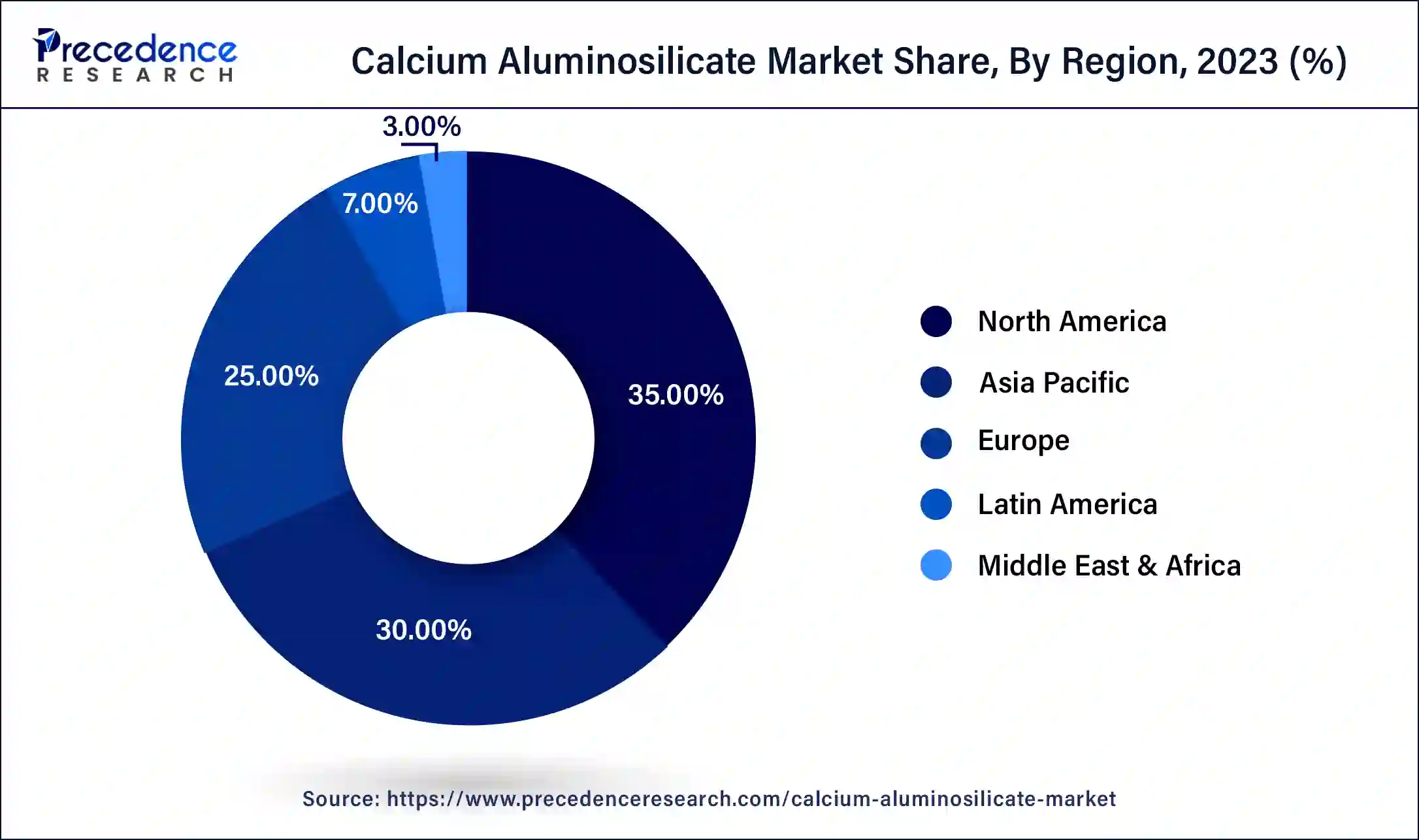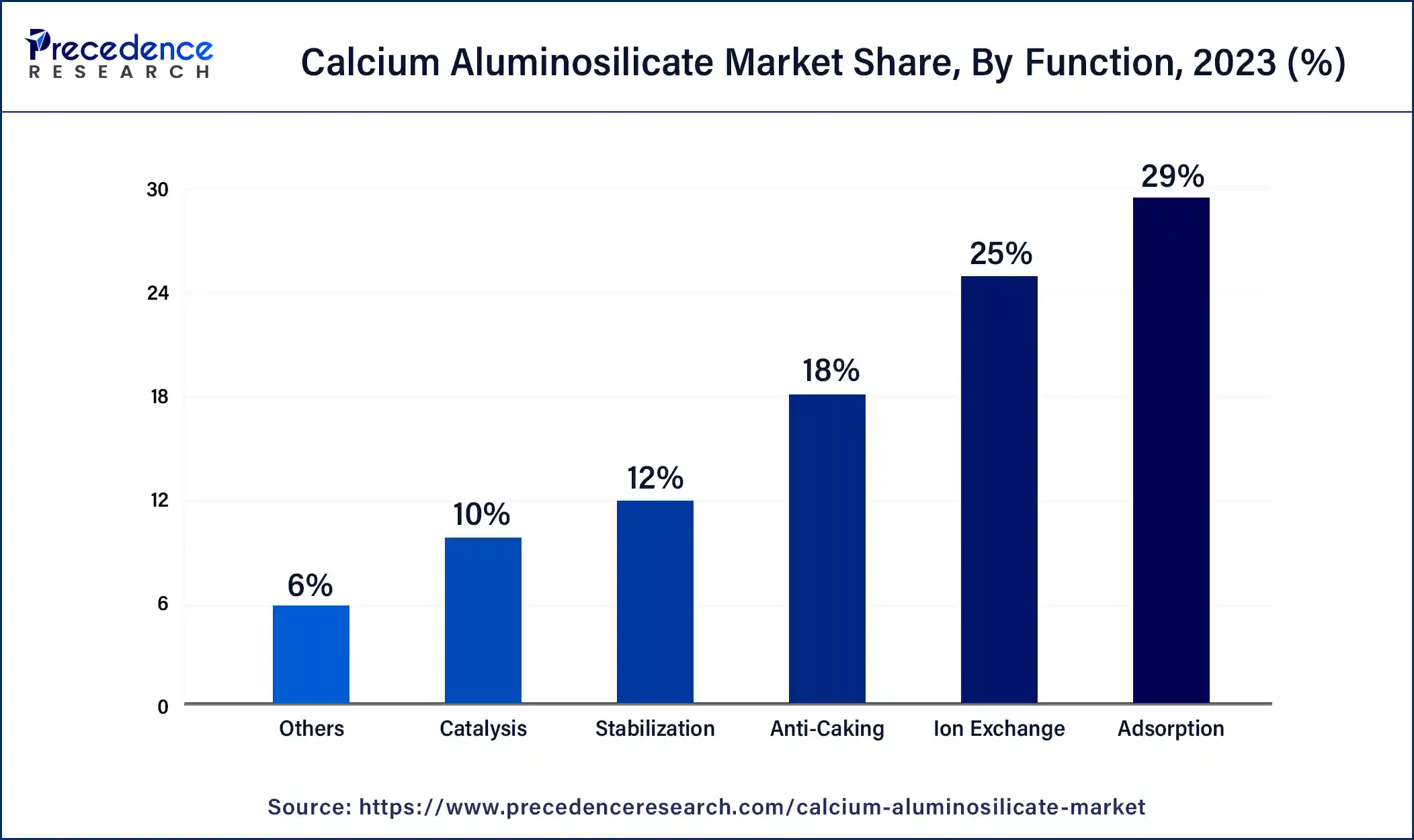December 2024
The global calcium aluminosilicate market size accounted for USD 4.18 billion in 2024, grew to USD 4.37 billion in 2025 and is predicted to hit around USD 6.56 billion by 2034, expanding at a CAGR of 4.61% between 2024 and 2034. The North America calcium aluminosilicate market size is calculated at USD 1.46 billion in 2024 and is projected to grow at a CAGR of 4.73% during the forecast year.
The global calcium aluminosilicate market size is calculated at USD 4.18 billion in 2024 and is anticipated to reach around USD 6.56 billion by 2034, growing at a solid CAGR of 4.61% from 2024 to 2034. The demand for calcium aluminosilicate is rising in several industrial applications. Calcium aluminosilicates are known for their excellent durability and chemical resistance. Thus, they are widely used to reduce spoilage in various industrial products, such as ceramics, concretes, and refractories.

The U.S. calcium aluminosilicate market size was evaluated at USD 1.02 billion in 2024 and is projected to reach around USD 1.64 billion by 2034, growing at a CAGR of 4.79% from 2024 to 2034.

North America dominated the calcium aluminosilicate market in 2023. The regional market growth is mainly attributed to the rising urbanization and the faster lifestyle that are boosting the demand for canned food and beverages. Moreover, the heightened demand for clean water and waste management augmented the market in the region, as calcium aluminosilicate plays a key role in removing pollutants from water.

Asia Pacific is anticipated to expand at a significant rate in the market during the forecast period. The growth of the market in the region is attributed to the rising population and the expansion of industries such as consumer goods, food and beverages, and construction. The rising government initiatives in wastewater management and rising construction activities further boost the calcium aluminosilicate market in the region. However, calcium aluminosilicate is used as an extender and filler in building materials like mortar and cement.
Calcium aluminosilicate is the most abundant group of rock-forming minerals. It is the combined mineral of the aluminum octahedral sheets and silica tetrahedral, which is both with the hydroxyl group and oxygen. Calcium aluminosilicate is also known as the E556 and is used as the food additive in several food products and as the anti-caking substance for table salt and vanilla powder. Calcium aluminosilicate has a high water adsorption capacity, making it suitable for different industrial applications. It is used as an additive in various food and beverage products; it restricts food products from forming a solid block. The rising awareness about environmental pollution and the water filtration activities for clean water supply in urban areas are boosting the growth of the calcium aluminosilicate market.
How Can AI Revolutionize the Calcium Aluminosilicate Market?
The integration of AI technology revolutionizes the entire process from production to application. Artificial intelligence (AI) algorithms have the ability to enhance production processes by analyzing data from manufacturing equipment and identifying variations. It also can predict equipment failures before they occur, minimizing downtime and maintenance costs, improving efficiency, and reducing waste. AI-powered systems monitor the quality of calcium aluminosilicate during the production process in real-time, ensuring consistent quality and products meet specified standards. AI also helps in the development of food additive manufacturing technology that creates the process for the production of innovative personalized food products. It helps analyze, collect, and process huge food additive manufacturing data and manages production.
| Report Coverage | Details |
| Market Size by 2034 | USD 6.56 Billion |
| Market Size in 2024 | USD 4.18 Billion |
| Market Growth Rate from 2024 to 2034 | CAGR of 4.61% |
| Largest Market | North America |
| Base Year | 2023 |
| Forecast Period | 2024 to 2034 |
| Segments Covered | Type, Function, End-use, and Regions |
| Regions Covered | North America, Europe, Asia-Pacific, Latin America and Middle East & Africa |
Rising demand in the pharmaceutical industry
With a significant growth in the geriatric population, the prevalence of chronic diseases is rising worldwide. This, in turn, drives the demand for healthcare and pharmaceutical products. However, calcium aluminosilicates are used as fillers and binders in tablets. They hold various formulations together and enhance the overall quality of tablets. The increasing focus on developing innovative drug formulations further drives the market.
High usage in cosmetics products
Calcium aluminosilicates play a significant role in the cosmetic industry. They are used as bulking agents to improve the texture and volume of the formulation. They are mostly used in cosmetic products like highlighters, eyeshadows, and nail polishes to create a reflective or shimmery effect. The quality of the cosmetics depends upon its properties, like the smooth texture, application, and blending of the cosmetics, and calcium aluminosilicate is the essential element in fulfilling the major quality requirements of the cosmetic products. In addition, the increasing usage of calcium aluminosilicates in several industries, including construction, cosmetics, and food & beverages, due to its unique properties such as anti-caking agents, insulation materials, absorbents, and fillers, which further helps in the expansion of the calcium aluminosilicate market.
Potential side effects
When consumed continuously for a longer period of time, calcium aluminosilicate can cause several side effects. Excessive consumption can lead to iron deficiency in the human body, psychological effects, and hypertension symptoms, which may limit the use of calcium aluminosilicate to a certain extent, thus restraining the market.
Increasing environmental concerns
The increasing concern over environmental pollution, specifically air and water pollution, is driving the demand for calcium aluminosilicate for the filtration of water and sustainable solutions for making water clean. The adoption of calcium aluminosilicate is increasing in the water treatment process due to its adsorption and ion exchange properties. The rising urbanization and industrialization are causing higher environmental pollution, especially water pollution due to industrial waste, which boosts the demand for a water treatment process with an environmentally sustainable solution. Additionally, the rising inclination toward sustainable and organic farming techniques contributes to the market’s growth, as calcium aluminosilicate nourishes the soil.
The natural segment held the major share of the market in 2023. This is due to the rising adoption of natural zeolites in various applications due to their properties, which can play the role of synthetic chemicals and different substitutes and perform the same process in natural formats without releasing carbon footprint and chemical reactions. Natural zeolites help in soil cultivation and absorb nutrients into the soil. They are also used in wastewater treatment, filters for fish farms and swimming pools, filtration for drinking water, filtration for the gas industry, animal nutrition, construction, human health, and others.
The adsorption segment dominated the market in 2023. This is primarily due to the rising adoption of calcium aluminosilicate adsorption in various industrial applications. Due to its ability to absorb heavy metals, pollutants, and toxins, calcium aluminosilicate adsorption is mainly used for environmental remediation, water treatment, poultry deeds, and soil conditioning. The rising focus on enhancing the productivity of farms with lower environmental impacts is contributing to the expansion of the segment in the calcium aluminosilicate market.

The agriculture segment is expected to grow at the fastest rate from 2024 to 2034. The rising global population and the continuous rise in the demand for food and clean water are driving the development of the agriculture sector. The rising usage of calcium aluminosilicate to improve soil texture and retain minerals like calcium, potassium, magnesium, and nitrogen in the soil for better crop quality and enhanced cultivation process contributes to segmental growth.

Segments Covered in the Report
By Type
By Function
By End-use
By Geography
For inquiries regarding discounts, bulk purchases, or customization requests, please contact us at sales@precedenceresearch.com
No cookie-cutter, only authentic analysis – take the 1st step to become a Precedence Research client
December 2024
January 2025
February 2025
February 2025